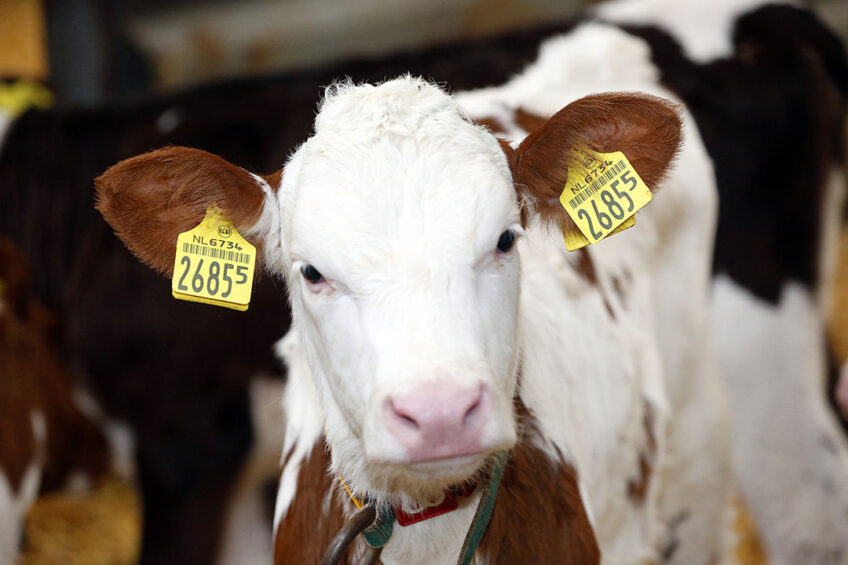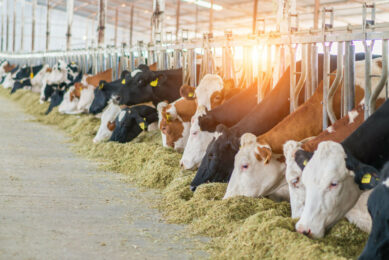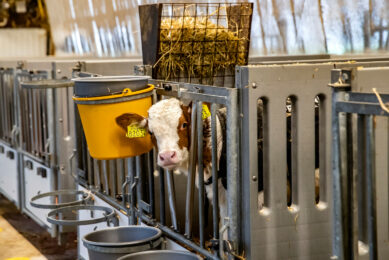Calf housing: Necessary improvements to boost productivity

Research in the US and Canada reveals new ways to look at housing with the aim to bolster calf development and improve long-term productivity.
Calf rearing is a labour-intensive task that doesn’t always go as planned and sometimes ends in mortality and morbidity. One of the 3 main causes of mortality and morbidity in calves is the housing environment, the other 2 being calf management and husbandry, and calf nutrition.
Mortality and morbidity a costly problem
Recent research from the Agri-Food and Biosciences Institute (AFBI) in Northern Ireland, for example, revealed major losses during the first weeks of life. Mortality rates were up to 6% in some cases. In 2006, the Department of Agriculture, Environment and Rural Affairs (DAERA) reported calf losses cost the industry an estimated £60 million per year. Furthermore, the Royal Veterinary College in the UK indicates more than 40% of calves on commercial farms in the UK suffer from pneumonia. Similar losses are seen in dairy-farming countries around the world.

Arguably, morbidity is the more costly of the two, as research (also from AFBI) demonstrates that illness in early life can lead to a reduced growth rate. Perhaps more importantly, they can also impact the farm’s long-term production efficiency through delayed age at breeding, and calving with a depressed level of milk production.
Ventilation challenges
Brian Dougherty is an Extension Agricultural Engineering Specialist at Iowa State University. For the most part, he works with dairy farmers on the smaller farms in the northeast part of the state. Average farm size in this region is 150 cows, but can reach as high as 700. In this region, ventilation is a big challenge in livestock buildings, said Dougherty. Ventilation issues lead to health challenges, and in particular, pneumonia.
Where pneumonia is a problem, Dougherty recommends working closely with a veterinarian to determine if the cause is the environment or contagious bacteria. If the problem is contagious bacteria (Salmonella or Microplasma bovis), ventilation is not going to solve the problem. In this case, producers will want to look at their colostrum management, energy intake, calf diets, bedding, vaccination program and general sanitation. Often, though, pneumonia is an environmental issue cause by organisms such as pastorales and histopholous. Then, said Dougherty, producers will want to look at their ventilation systems.
 Hoof health: 5 Prevention and control strategies
Hoof health: 5 Prevention and control strategies
Hoof health problems are major issues in dairy cattle that can cause tremendous economic losses.
While pneumonia is probably the biggest concern, poorly ventilated barns present other challenges as well. Good ventilation, said Dougherty, keeps bedding dry, controls odour, minimises heat stress and helps with fly control. The main goal with ventilation is to bring fresh air into the barn. “You don’t want to just recirculate air that’s already there,” said Dougherty. “You need to get the heat, the moisture, the noxious gases and the dust and the airborne pathogens out of the barn.”
Crucial in calf barn design
In the northern part of the state where farms are smaller, calves are traditionally raised in huts. Producers find them easier to manage and, for the most part, calves are healthy. As farms increase in size, though, there’s more interest in building calf barns.
If you’ve got 5 or 10 calves it’s maybe not a huge deal to feed them in huts, but when you have hundreds of calves that’s not a fun job in the wintertime when it’s below zero,” said Dougherty.
Today, many farmers are constructing or retrofitting new facilities for their calves. Housing calves in barns can improve comfort and worker satisfaction, as well as efficiency. Before retrofitting a barn, Dougherty likes to assess the space. He looks at temperature and relative humidity, ammonia concentrations (>5ppm is ideal), and air speed under fans and through inlets. Using a fogger, he checks airflow patterns. This allows him to determine how many air changes the barn gets each hour.
In winter, a minimum 4 changes per hour is recommended. In summer, 40–60 air changes per hour are recommended. In moderate temperatures, 15–20 changes per hour is the recommendation. This can be accomplished through natural ventilation or using mechanical ventilation.
While most farmers still opt for natural ventilation, an increasing number are installing a positive pressure tube. It’s a fan on the external wall that forces air into the building through a round tube with holes in it. In a 40 by 100-foot calf barn, a positive pressure tube would cost approximately USD$1,500–2,000 to install, said Dougherty. “We can design these tubes so they direct air at the proper air speed and get that air in the proper location,” he said. “So you can get fresh air down to the calves without creating a draft on them.”
 Sustainability and Welfare special: Reserve your space
Sustainability and Welfare special: Reserve your space
Dairy Global, All About Feed, Pig Progress and Poultry World are publishing a special magazine on Sustainability and Welfare in October
Producers who opt for individual pens inside the barn will also face challenges, said Dougherty. The dividers are good for biosecurity and preventing the transfer of disease, but create ventilation challenges. It’s essential that fresh air is able to get down into the pens. This is where positive pressure tubes are a good fit, he said.
For sidewall construction Dougherty recommends no more than 45 cm of concrete on the bottom and curtains the rest of the way. Choosing a split curtain design will provide further flexibility in terms of ventilation. Finally, the narrower the barn, the better the ventilation system will work. “If I was going to build a building, I would naturally ventilate it and put in one of those positive pressure tubes,” Dougherty concluded. “That seems to be the best system right now for calf health.”
Producers opting for natural ventilation need to be aware that parameters outside the barn can impact air movement too. Spacing barns too close together or too close to other out buildings can create wind shadows, for instance. Furthermore, when the temperature outside the barn is warmer than inside the barn natural ventilation won’t work well either.
What should happen is air should come in evenly along the side of the building,” said Dougherty.
“If it’s cold air it should drop down and gently move that warm moist air up and out the ridge. But if you have the temperature inversion and the outside air is warmer it comes in the eave and just goes straight out the ridge. And then you end up with polluted air down where the calves are.” It’s in these instances where positive pressure tubes can really help, he added. Specific design requirements for positive ducted ventilation can be found in the AHDB document, Better cattle housing design.
Beyond ventilation, Dougherty recommends an all-in, all-out approach where producers empty out the barn and let it sit for a week or two after it has been cleaned and disinfected. This will help lower disease incidents and improve overall health.
Calves that had a social companion also started eating solid food sooner than individually housed calves.
 Coccidiosis: A look at when dairy calves are at higher risk
Coccidiosis: A look at when dairy calves are at higher risk
Dr Tim Potter, from Westpoint Farm Vets in the UK, explains the reasons behind the increased risk of coccidiosis.
Benefits of calf pairing
While many producers choose to house calves in individual huts, research in Canada reveals the benefits of paired housing. Dalhousie University Assistant Professor Dr Rebecca Meagher and her colleagues examined the impact of early pair housing on calf development, welfare and long-term productivity. Specifically, the researchers wanted to see if increased sociability through paired housing impacts calves’ ability to explore their environment and learn from each other through that exploration.
Research also showed that calves raised in more complex social environments are less afraid of novelty.
“A lot of animals gain from that as they feel safer in groups and they can learn from each other,” said Meagher. Although all of the calves were capable of learning, flexibility ranged. “If things changed in their environment, the ones that had been individually housed weren’t good at adapting to that change,” said Meagher. “And that could potentially be a problem on farms where they’re exposed to changes as they move through the system. They might have a harder time adapting if they haven’t been raised with social contact.”
The research also showed that calves raised in more complex social environments are less afraid of novelty. Calves that had a social companion also started eating solid food sooner than individually housed calves. This is attributed to increased levels of comfort and exploration through social contact. Even calves that were put with a social partner after 6 weeks of age ate less solid feed than those that had had a partner with them earlier on, she said.
“It seemed to have some sort of lasting effect beyond the time they were individually housed,” she said. “In practical terms, if they don’t get eating solid feed as early then they’re going to have a harder time at weaning and then probably they’re going to be less productive, and they’re going to grow less quickly in that period after weaning.”
 How to ensure a calf gets the best start?
How to ensure a calf gets the best start?
These are the 2 key factors for a great start to a calf’s life.
Furthermore, studies show that female calves that grow faster when they’re young are likely to produce more milk in their first lactation, Meagher added. At this point, researchers don’t know exactly when it’s best to pair young calves. It’s a question that needs more research, said Meagher. Her work did show that pairing should be before 6 weeks of age, though.
Meagher warns that pairing calves too early can present risks, as young calves are susceptible to disease. Meagher’s best guess is to put calves together around the time they move to solid feed, somewhere around 3–4 weeks of age. What is clear, though, is that the benefits of eating solid feed sooner last into the long term. Despite the fact that they’re not getting a lot of the nutritional value from it, solid feed has the benefit of preparing the rumen for later.
When we wean calves off milk usually there’s a period of days or a week when they stop gaining weight, but if you have them eating more solid feed before weaning happens, then you see less of that drop in weight gain,” Meagher concluded.
More research
The Dairy Youngstock research team at AFBI Hillsborough is currently conducting a large-scale calf housing project, called OptiHouse. The project involves dairy farms across Northern Ireland. The aim of the project is to get a better understanding of the key factors linked to sub-optimal environmental conditions in youngstock housing, as these conditions can significantly impact calf health and performance. Another goal of the project is to develop blueprints for modern calf housing, as well as offer fixes for existing designs. Calf considerations include: air quality, social interactions, growth performance, and space allowance. Producer considerations include: labour efficiency and flexibility, scalability, cost to build and operate, integration within the farmyard, and degree of mechanisation.
The developed blueprints will be developed to suit the climate and production variations of Northern Ireland. Along with the on-farm work, the researchers will carry out a series of controlled studies to determine the impact of and interactions between level and type of calf nutrition, bedding, calf grouping and environmental conditions. Currently, a series of OptiHouse seminar videos is available to view on the AFBI website.
Additionally, hygiene and ventilation Jamie Robertson of Livestock Management Systems in Scotland developed a series of how-to calf management videos.
Join 13,000+ subscribers
Subscribe to our newsletter to stay updated about all the need-to-know content in the dairy sector, two times a week.










